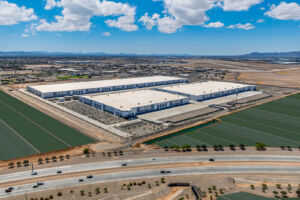Buoyed by double-digit tech-sector employment growth, Phoenix was in the top third of markets in the country for rising office rents over the past two years, with 13.4 percent growth, according to CBRE’s annual Tech-30 report, which measures the tech industry’s impact on office rents in the 30 leading tech markets in the U.S. and Canada. Furthermore, Tempe saw the highest tech rent growth of any submarket in the country with just under 30 percent growth over the same period.
The influence of tech industry job creation on office market rent growth is pervasive across the U.S. and Canada, with 13 of the Tech-30 markets posting rent growth of 10 percent or more between Q2 2015 and Q2 2017. Phoenix’s high-tech employment grew 25.4 percent over 2015 and 2016, with average office asking rents rising 13.4 percent to $25.01 from Q2 2015 to Q2 2017. Tempe’s average office asking rent is $28.35.
“Overall, Metro Phoenix’s office market is performing well, with tech being a major driver,” said Bryan Taute, executive vice president with CBRE’s Phoenix office. “Downtown Phoenix and Scottsdale continue to garner attention from tech companies, but Tempe tops the charts in terms of tech rent growth. All of these areas have seen significant demand from tech companies looking to draw from a high concentration of millennials, whom they hope will fulfill their current and future labor needs. These areas also benefit from being centrally located, amenity-rich, walkable and nearby to Sky Harbor International Airport.”
“Of the top 10 markets for tech rent growth, Metro Phoenix is one of the most affordable from an office rent standpoint,” said Kevin Calihan, executive vice president with CBRE’s Phoenix office. “With prime office rents in Austin and San Francisco reaching north of $60 per square foot and $100 per square foot, respectively, and only a handful of buildings in Metro Phoenix reaching $40 per square foot, Metro Phoenix is still far more affordable than many of the other markets it competes with.”
Emerging Submarkets
According to CBRE’s Tech-30 report, the willingness of tech companies to pay a premium for office space in the hottest tech submarkets is starting to spill over into neighboring submarkets as available space in tech hotspots is dwindling. As a result, adjacent submarkets and traditional downtowns with skylines—rather than the brick-and-beam buildings tech companies have demonstrated a preference for—are primed to benefit, creating opportunity for commercial real estate investors.
“Office rents have increased in every primary tech submarket over the past two years, illustrating stiff competition among tenants to locate in talent-rich areas such as Tempe, East Cambridge, Minneapolis’s North Loop and South Orange County, all of which have very low office vacancy,” said Colin Yasukochi, director of research and analysis for CBRE and the report’s author. “If tech companies that are used to paying a premium for space in the top tech submarkets are forced to move to adjacent submarkets in order to expand, we could start to see significant rent growth in those more traditional markets as well.”
The research found that the top tech submarkets with the lowest vacancy rates are East Cambridge (3.3 percent), Palo Alto (3.7 percent) and Mount Pleasant/False Creek in Vancouver (4 percent) as of Q2 2017. The office rent premium paid by tenants in these markets continues to widen, with average rents for top tech submarkets increasing faster than their broader markets, with an average premium of 16.2 percent (also based on Q2 2017 data). That figure jumps substantially for markets at the top of the Tech-30 list, including East Cambridge (120 percent), Palo Alto (71 percent) and Santa Monica (92 percent). Tenants in Phoenix’s top tech submarket, Tempe, pay a premium of 13.4 percent compared to the broader market.
Conversely, several emerging tech submarkets have rent discounts, including Hillsboro, Oregon (-19 percent) and Northeast Charlotte (-18 percent).
Tempe was the top submarket for net absorption growth from Q2 2015 to Q2 2017, at 33.2 percent, followed by Nashville (13.5 percent), Seattle’s Lake Union (27.5 percent) and Salt Lake City’s South Valley (19.3 percent).
“The creation of new market opportunities via disruption and a growing number of industries integrating technology into their business models support an optimistic outlook for continued growth ahead. Commercial real estate investors should benefit from the trends that have given the tech industry greater stability and a wide economic base compared with previous economic cycles,” said Chris Ludeman, Global President, Capital Markets, CBRE.
“Ups and downs are a natural part of the business cycle, and real estate investors should manage their risk and exposure to the most volatile sectors of the tech industry accordingly. Tech-30 office markets should expand further in the near term, albeit at a slower pace. Realistic growth expectations, valuations and viable exit strategies by tech firms will protect investors from potential losses that were unforeseen during the last tech cycle,” added Mr. Ludeman.
Top Job Growth Markets
For the sixth consecutive year, San Francisco was the top Tech-30 market for high-tech job growth; its high-tech job base grew by 39.4 percent over the past two years, while its average asking rent increased by only 7.1 percent. Charlotte (31.6 percent), Pittsburgh (31.4 percent), Indianapolis (27.8 percent) and Phoenix (25.4 percent)—all low-cost markets—had the next highest job growth rates and rent increases of 16.9 percent, 3.5 percent, 6.5 percent and 13.4 percent, respectively.
Top Rent Growth Markets
Double-digit office rent growth was achieved in 13 markets over the past two years, led by Orange County (23.3 percent), Nashville (21.2 percent), Atlanta (17.6 percent) Charlotte (16.9 percent) and Silicon Valley (16.8 percent).



